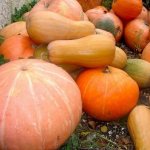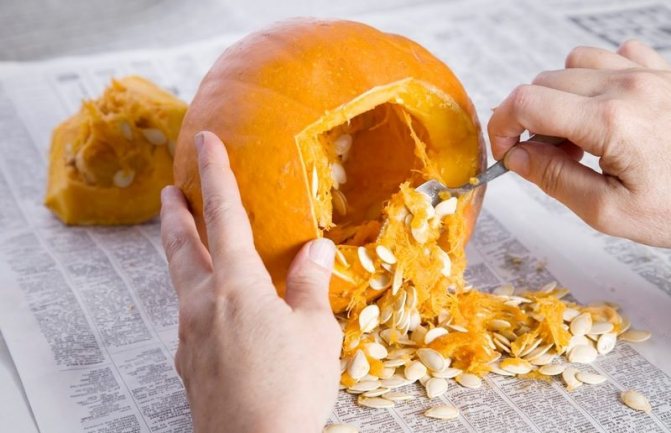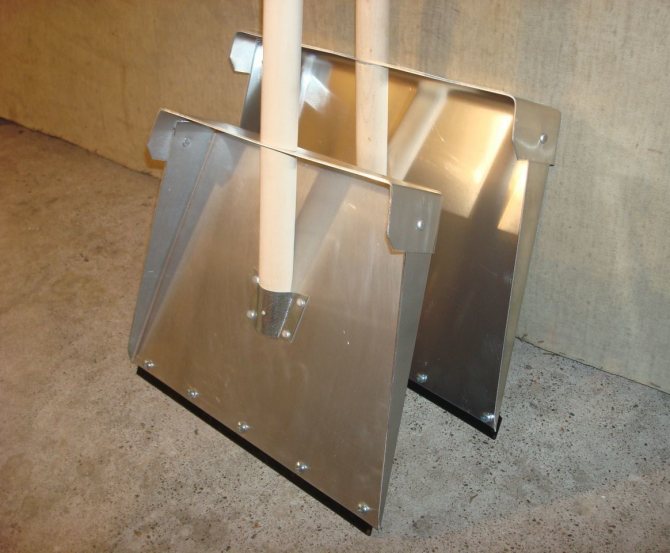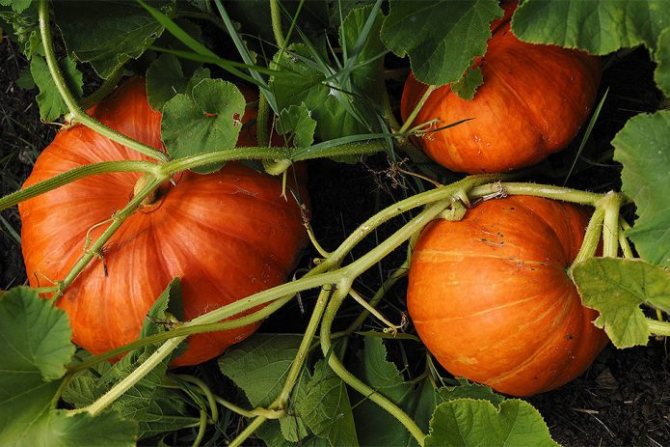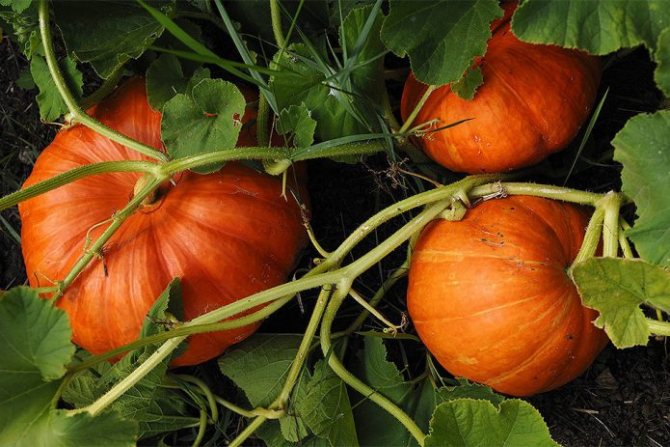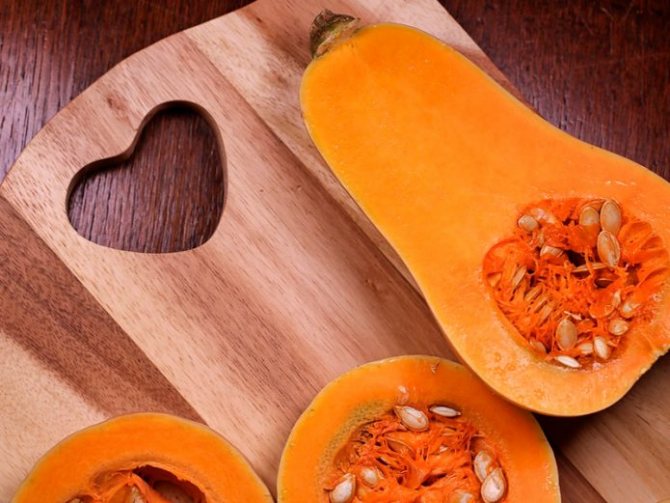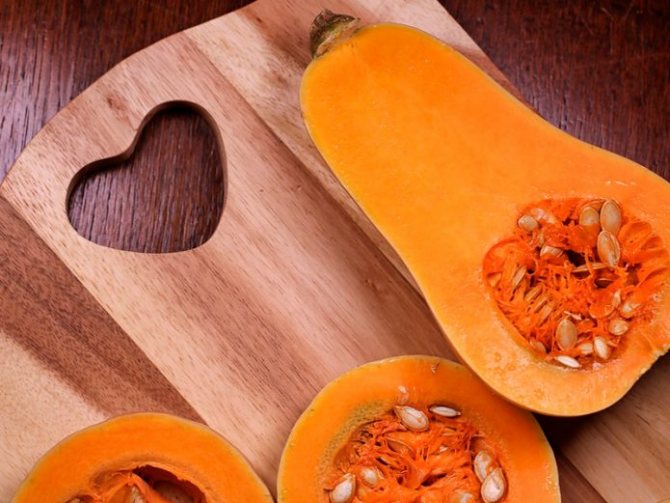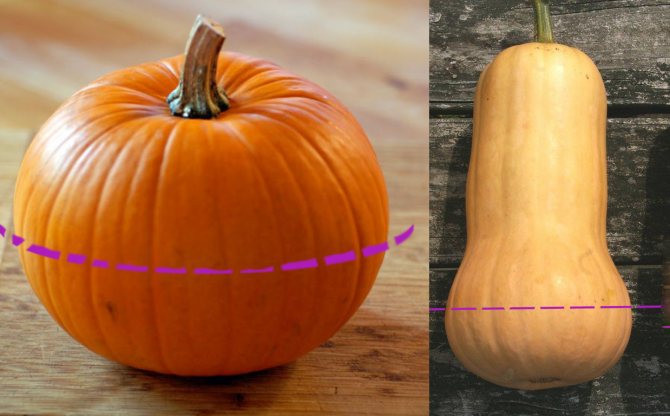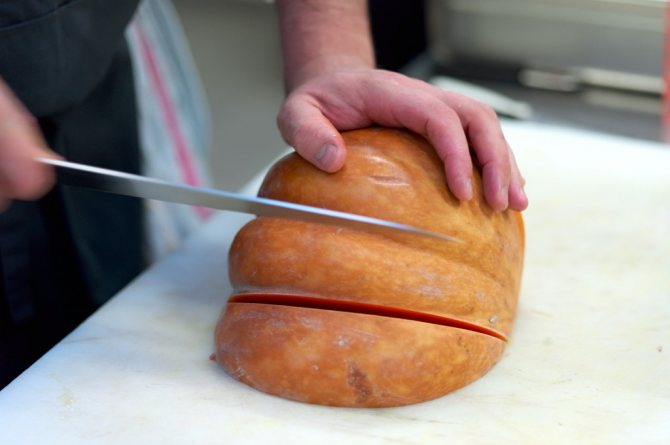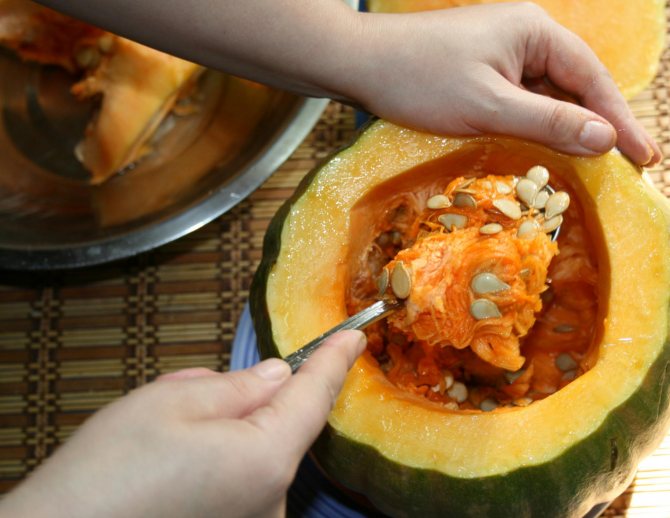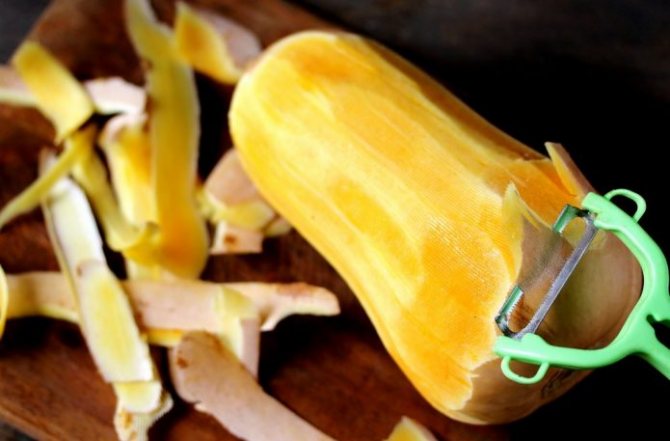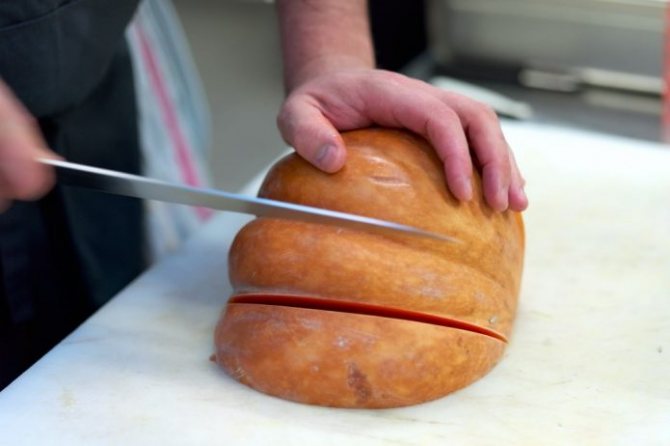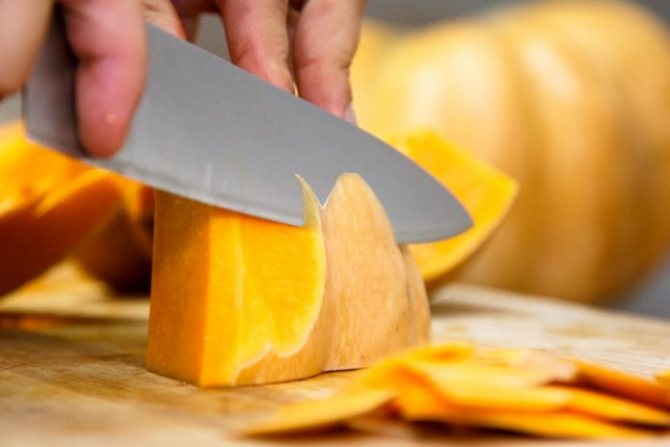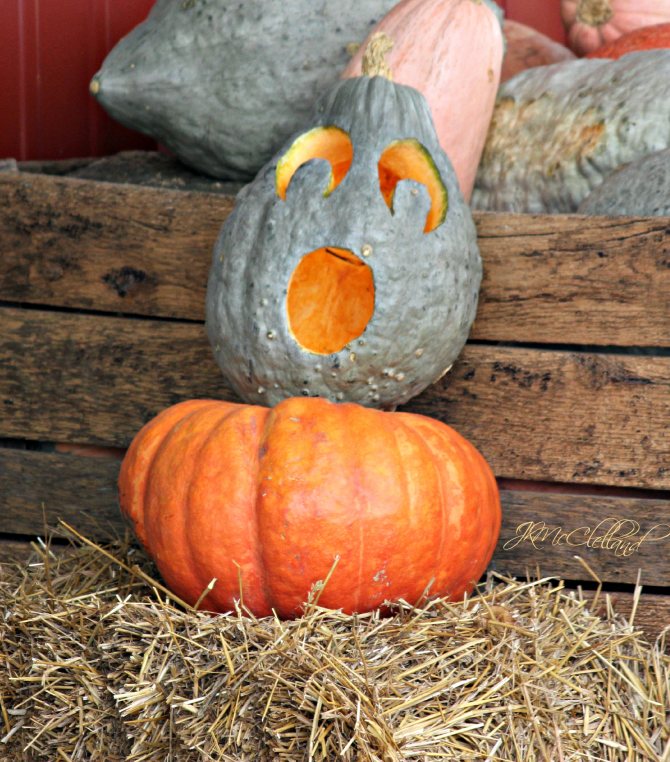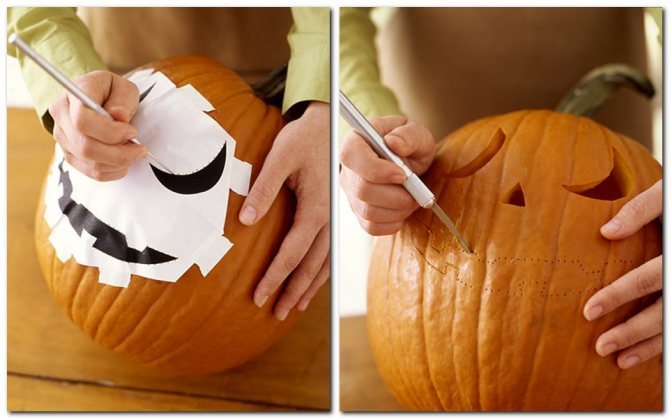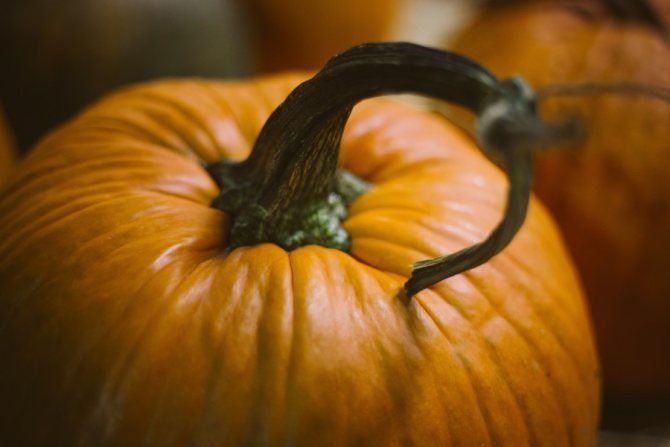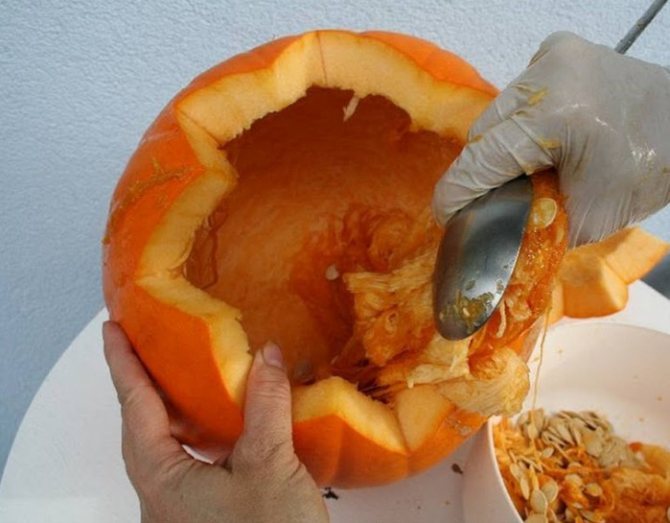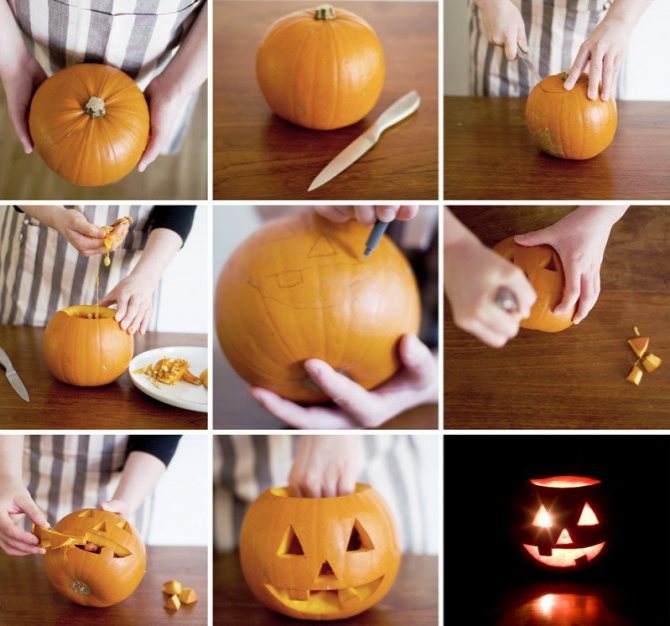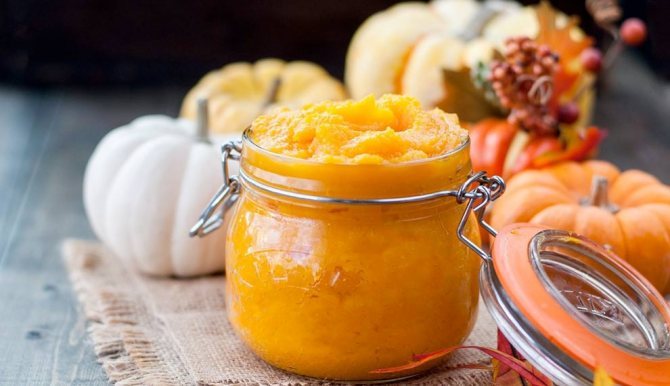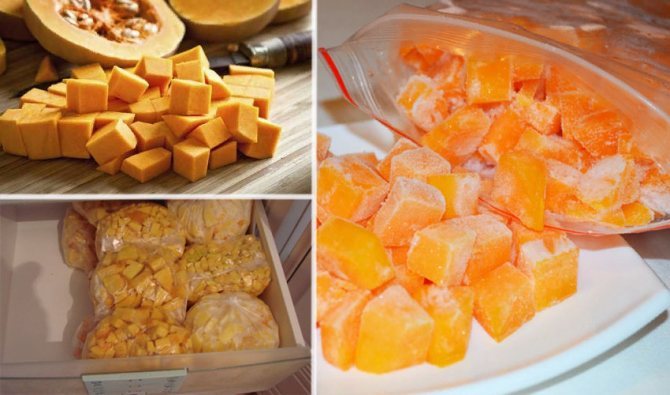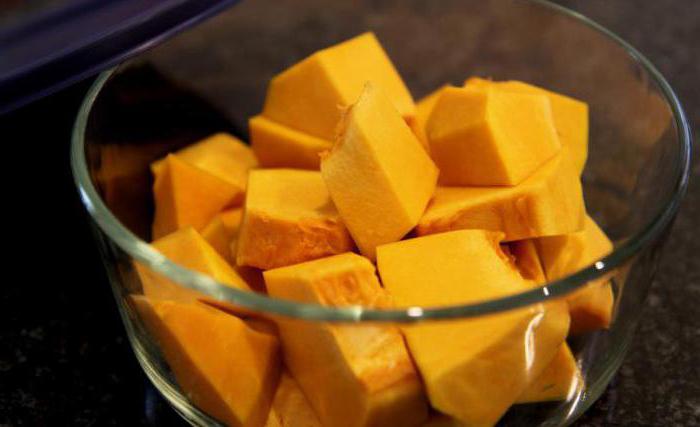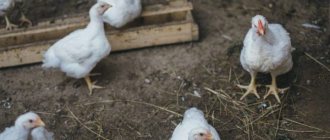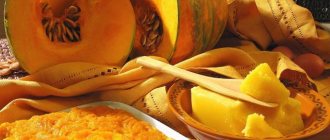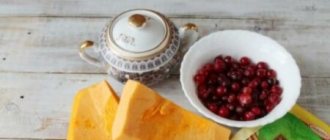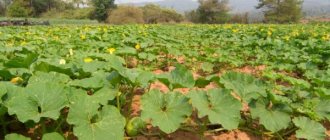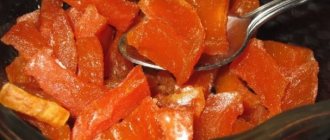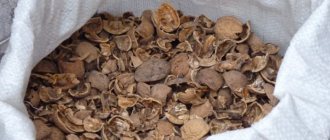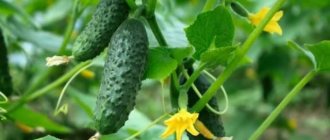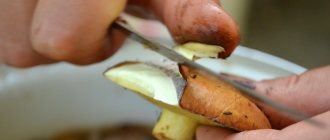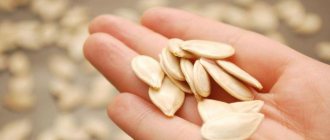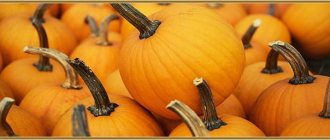Today pumpkin is actively used in cooking. Its pulp is used for preparing first courses, salads, or baked in the oven. Despite the fact that this culture is capable of lying for a fairly long period of time, many housewives prefer to freeze the product. Undoubtedly, you will have to peel the pumpkin in any case if you plan to use it for cooking. Since the peel can be quite tough, the peeling process can take a lot of time and effort.
Peel softening methods
I experimented with the preliminary preparation of the fruit before peeling. I read all these methods on the Internet, they were not taught to me by my mother or grandmothers. Two methods are thermal and one method is water.
First: soaking pumpkin in water
I soaked the pumpkin, which had been kept at room temperature for a long time and its peel became stiff, that is, dried out. ))
I put the pumpkin in a bucket of cold water overnight: relatively large fruits do not fit in a regular bowl. And left her to soak overnight.
In the morning, the skin absorbed water and became as if younger and fresher. And more malleable. Then I cleaned it according to the standard scheme in steps. The method has been tested, you can use it!
Tips to make the process easier
The experience of gardeners and pumpkin lovers has helped to find several ways that make it easier to remove the tough skin from a vegetable.
Soak
To facilitate the cleaning process, the fruit is soaked in cold water and left overnight. In the morning they take it out and wipe it off with a towel. This method works well for nutmeg and large-fruited varieties with a tough skin, but hard pumpkins cannot always be softened in this way.
Short heat treatment
It is better to soften tough woody rind by heating. Pierce the prepared pumpkin with a fork, skewer or a narrow knife on several sides. Place the food in the microwave and set the switch to maximum. After two minutes, remove and, while the pumpkin is still warm, cut the peel. Divide the large vegetable into parts.
Note that for thin-skinned and juicy varieties, one minute is enough for the shell to become more pliable to remove.
You can also send the pumpkin to an oven preheated to 150 ° C for 15–20 minutes. Make sure not to overexpose the fruit, otherwise the pulp will bake and you will have to immediately use it for cooking.
Immediately after heat treatment, the peel from the pumpkin can be removed with a regular grater.
Using special tools
The peel from the raw fruit, in addition to the peeler, is removed with a special knife, consisting of many ring-shaped blades. Pressing lightly on it, you need to walk over the entire fruit from the tail to the bottom. Such a device is suitable for processing small vegetables with a thin shell, as well as tough, not overripe pumpkins recently removed from the garden.
Video: using a knife to peel a pumpkin using an orange as an example
What kind of fruit is this vegetable
Pumpkin has been known for over 5 thousand years. The place of origin is Central and South America, where the ancient Indians began to use it. The fruit was brought to Russia in the 16th century.
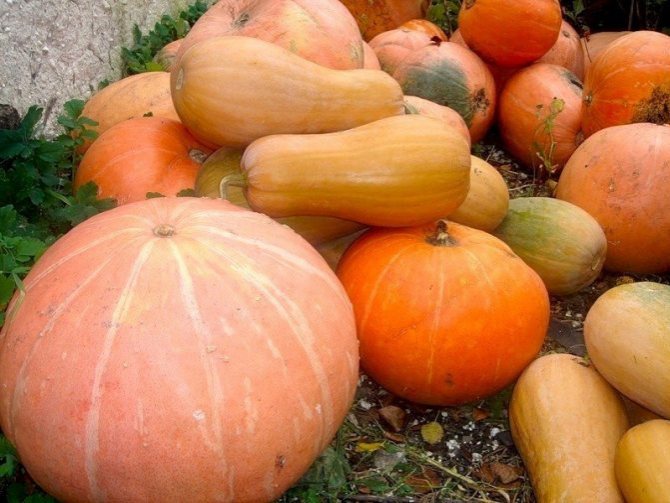
The usefulness of pumpkin for nutrition can hardly be overestimated.
There are many varieties of pumpkin. They differ in color and size, shape and purpose.There are decorative varieties, the pulp of which is inedible, but the unusual shape and color of the fruit can decorate a garden plot or a winter garden. Some varieties are grown for livestock feed or for seeds. Currently, three types are most often cultivated:
- large-fruited;
- firm-mouthed;
- nutmeg.
Large-fruited
The name of these varieties speaks for itself. The fruits are large in size and weight, they are also the sweetest. In some varieties, the sugar content reaches 15%, which is more than in the sweetest watermelon. The peel of such pumpkins is rather thin, while they are well stored in a city apartment.
The weight of this species can reach a centner; there is a known case of growing fruits weighing more than 500 kg. The fruits are usually round or oblong. There is a large cavity with seeds inside.
The large-fruited varieties include the “Stoun-pound”, “Titan”, “Kupchikha”, “Teschenka” and others. The varieties are resistant to low temperatures.
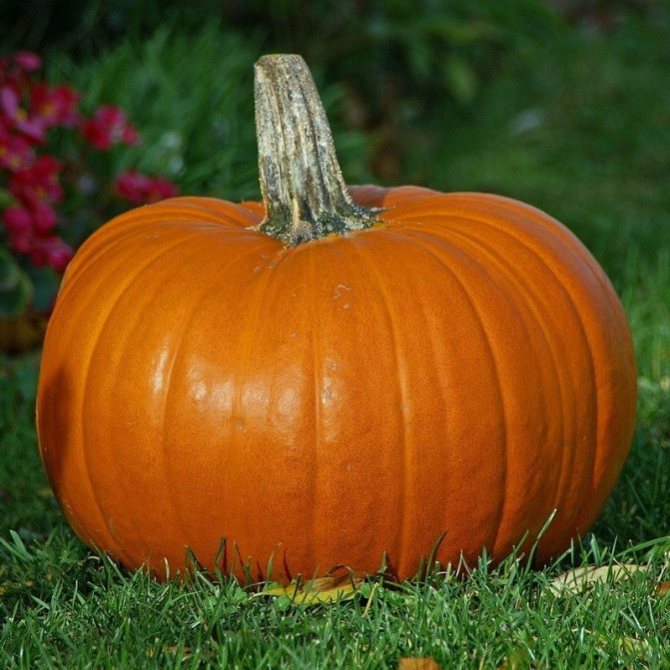

Some pumpkin specimens can reach several hundred kilograms.
Hard-faced
It is inferior in size to large-fruited and has a very hard peel, more like a nutshell. This species matures quickly. Already in late August - early September, they can be eaten. Hard pumpkin seeds are the tastiest.
Peculiarities of cleaning depending on the type and variety of pumpkin
Today, a large number of varieties can be found on sale, which may differ not only in shape and size, but also in the thickness of the peel. Conventionally, 3 types can be distinguished:
- Hard varieties - in this case, the peel can be compared in terms of hardness to the bark of a tree, as a result of which peeling will be quite difficult. A distinctive feature is the late ripening and sugar taste.
- Large-fruited varieties - include a large number of species. Sometimes the pulp is compared to watermelon. The rind in this case is much softer than the previous version.
- Muscat varieties - the crop is harvested in an immature state before the onset of the first frost. A distinctive feature is considered to be quite juicy and crispy flesh. Due to the fact that the peel is thin, the peeling process does not take much time.
In addition, it is worth taking into account the fact that all existing varieties are subdivided into summer and winter. Thus, fruits of summer varieties have a thinner skin than winter varieties, which are intended for long-term storage.
What you need to create Jack Lantern
To transform an ordinary vegetable into a magic lantern, you need to arm yourself with some tools. To create a Halloween pumpkin yourself with your own hands, you will need:
- orange or yellow vegetable;
- knives (preferably of different sizes and lengths);
- awl;
- marker;
- printed template (different templates are waiting for you at the very end of the article!);
- a spoon with sharp edges, a scraper;
- Scotch;
- scissors;
- candle, flashlight or garland.
These items will help to properly cut and make the main attribute for the holiday.
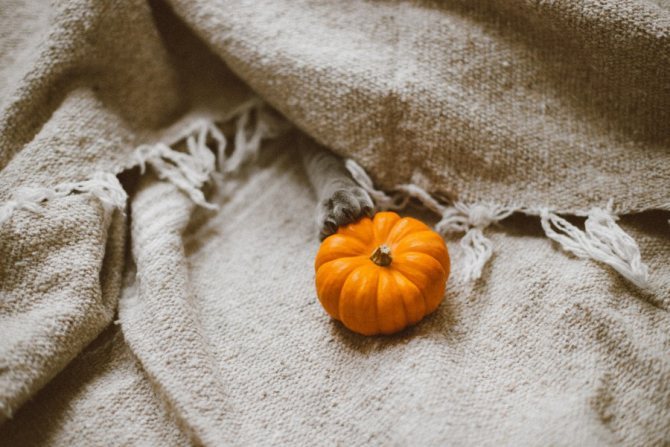

To make the lantern look beautiful, you need to choose the right vegetable. Pay attention to its appearance. It should be even and smooth, free from dents, scratches and other defects.
The armor is strong, but our hands are quick: how to peel a pumpkin
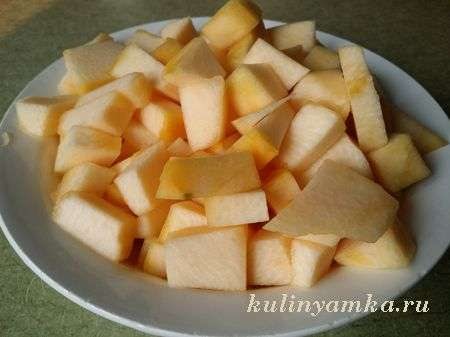

Pumpkin is healthy and tasty if you know what and how you can cook from it. And there is something to cook from it. Milk porridge with millet or rice, salads, pies, muffins and pancakes will diversify the table of lovers of this vegetable from autumn to spring, or even until the newest harvest.
Novice culinary specialists sometimes do not know from which side to approach it and how to clean the pumpkin. With a very hard, thick peel and a mass of seeds inside - it often causes bewilderment among those who first took to cooking something from it.
And you always need to start with the fact that the pumpkin, like any other vegetable, should be thoroughly washed.Then, wipe it dry with a towel or napkin.
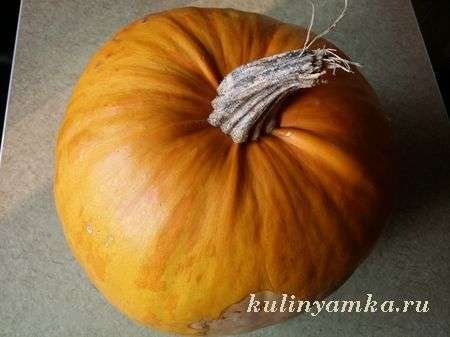

Take a wooden board and a large, sharp knife. Cut the fruit in half. The pumpkin can be very hard and it will take a lot of effort to do it.
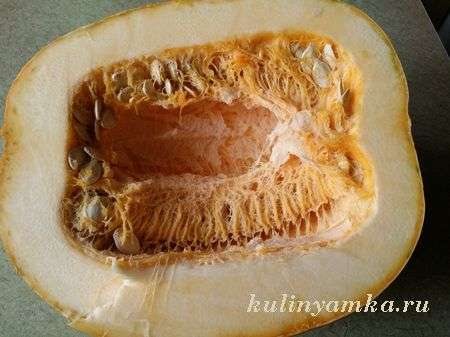

Inside each half, you will find a notch filled with seeds and fibrous pulp. All this must be removed directly by hand. The fibrous part can be thrown away, and the seeds can be washed, dried and eaten.
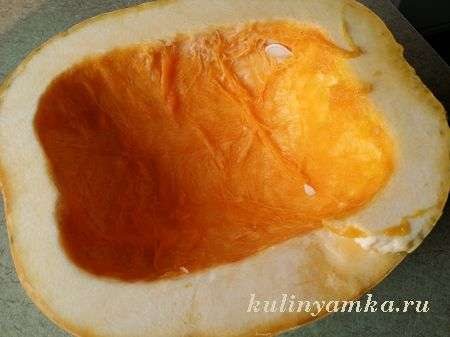

Next, each half of the pumpkin must be cut into pieces that are convenient for peeling. It can be flat long heads and squares. Cut it however you like.
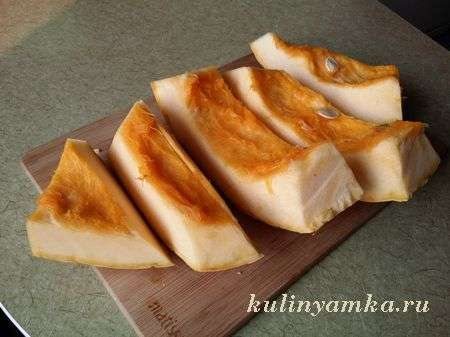

And now, each such piece must be cleaned from the inner fibrous layer, which is not at all thick, and then, from the hard skin on the outside of the piece.
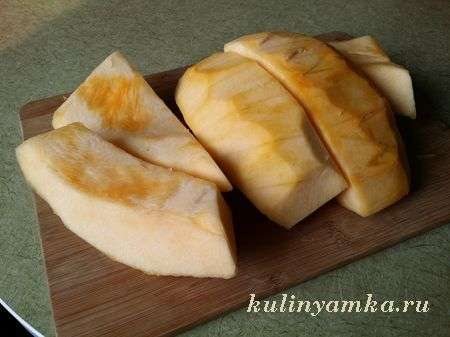

Pieces of pumpkin prepared in this way can be chopped even more finely or grated. It depends on the further method of its preparation. Usually, a whole pumpkin is not used in one go. After all, as a rule, these are large, several kilograms of fruits.
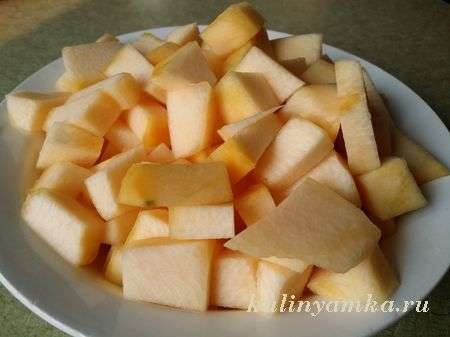

You don't need to peel the pumpkin all at once. Leave one half whole, with a fiber-seed center inside and put it on the refrigerator shelf. It will stay like this for several days, and you can once again cook something delicious out of it.
To prevent the edges of the pulp from drying out, the pumpkin can be tightened with cling film. You can also store already peeled pumpkin pieces in it.
If in the near future you do not expect to cook anything else, put the pumpkin in the freezer. It can be stored there both in grated form and in the form of plastics, packaged in plastic bags. The volume of such a package is best done for use at a time.
Frozen pumpkin slices can be cooked without defrosting. The same porridge, pastries and a good side dish for cutlets will delight you all winter and spring.
Little tricks
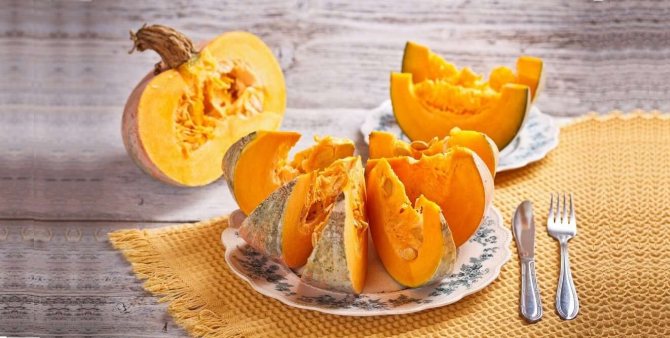

You don't have to use all your strength or find the sharpest knife to easily peel a pumpkin. You can pierce the vegetable in several places with a toothpick and set it in the microwave for 2 minutes. Be sure to set the equipment to maximum power. This will help soften the skin, making the removal process much faster and more pleasant. The only drawback of this method is that the skin heats up and it is inconvenient to hold it with your hands, but you can pierce the vegetable with a fork and hold it during cleaning.
Sweet Yalta onion: useful properties and growing rules
An oven is also suitable for quick removal of the top layer. To do this, the vegetable is left inside for 10-15 minutes, and then the peel is removed from the surface. By the way, after heat treatment, the fibers from the pulp do not stick to the skin plates, so this method is an economical cleaning.
The whole vegetable is not always used for cooking, and then the leftovers have to be thrown away. But they can also be frozen next time by cutting them into small cubes. Store pumpkin in plastic bags in the freezer for easy retrieval later. A frozen vegetable tastes the same as a fresh one. If the freezing process was performed correctly, then the vitamin composition in this case is preserved.
You can make it easier for yourself the cooking process and make mashed potatoes from the vegetable in advance. It is convenient to store it in the freezer, and you can not talk about the usefulness of a semi-finished product.
If the pumpkin is used as a base for fresh juice, then for long-term storage in the refrigerator, it is recommended to add a little lemon juice. It is enough to squeeze it onto the pulp. It is not worth keeping the ready-made juice in the refrigerator, since the nutrients in the liquid last much less time than in the pulp.
Pumpkin dessert will be tastier if you add a little honey instead of sugar. The thick aroma and pleasant aftertaste will go well with the soft and juicy heart.
Valuable properties
The composition of this vegetable is quite unique.It contains 90% water and only 10% vitamins and minerals. Due to this, it is widely used in dietary nutrition. Pumpkin pulp is rich in vitamins P, PP, C, D, A and B. Of the minerals it contains iron, fluorine, phosphorus, calcium, potassium, copper and zinc.
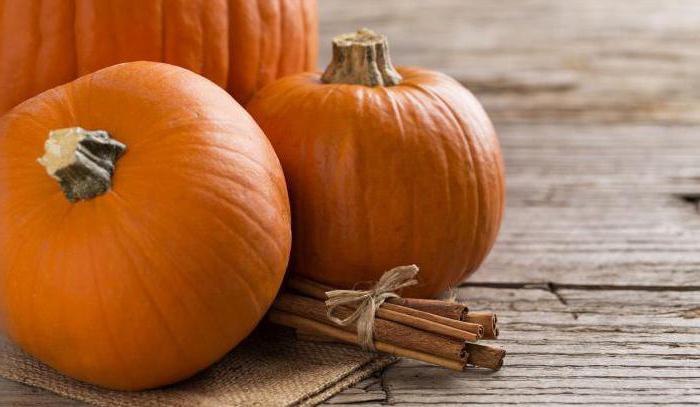

For those who do not know whether pumpkin is peeled from the peel, it will be interesting that it is shown to people who have various problems with the work of the cardiovascular system. It is also recommended to include it in the diet for those who suffer from sleep disorders and metabolic disorders. In addition, regular use of this product has a beneficial effect on the condition of the stomach and duodenum.
Due to its high fiber concentration, this orange vegetable is quickly digested and perfectly absorbed by the human body. In addition, it has excellent diuretic properties. The systematic use of this product helps to increase immunity and improve the general condition of the body.
How to clean a pumpkin for cooking
Nov 15 • Uncategorized • 8 Views • No Comments on How to clean a pumpkin for cooking
Content
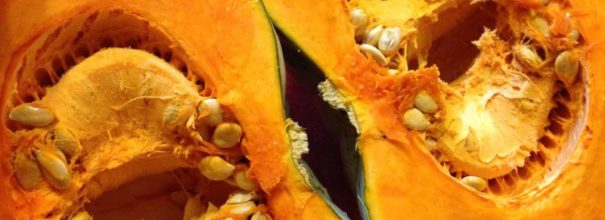

Thanks to the vitamins A, C, E, group B, PP, microelements (potassium, magnesium and others), fiber, pectin contained in pumpkin, it rightfully occupies a leading place in terms of usefulness in human nutrition. It is suitable for children, including infants, the elderly, and pregnant women. The unique composition of the pulp makes the vegetable useful for preventing the development of cardiovascular diseases, it has a diuretic, antiemetic effect, helps to fight toxicosis of pregnant women, insomnia. The vegetable helps with anemia and exhaustion of the body, liver diseases and many other diseases. Its seeds are no less useful. Regardless of the part, pumpkin should be properly peeled before use.
Features of pumpkin, popular varieties
The pumpkin is called the queen of the garden. It contains a huge amount of nutrients. The varietal diversity of this culture is amazing. Depending on the main characteristics, all pumpkins are usually divided into three main groups:
- nutmeg;
- hardy;
- large-fruited.
Butternut squash is the sweetest. The fruits are most often elongated. They have a thin skin that is easy to clean. The most popular varieties from this group: Cello, Spanish guitar, Muscat de Provence, Vitamin.
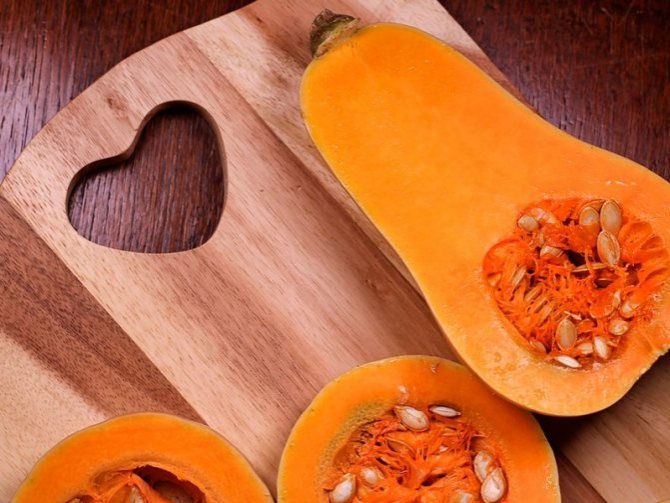

Butternut squash is easy to peel
Large-fruited pumpkins are large in size, but their skin is relatively thin. If the fruit is fresh, it can be easily peeled with a knife, after cutting it into pieces. This group includes varieties such as Russian porridge, Titan, Gigant.
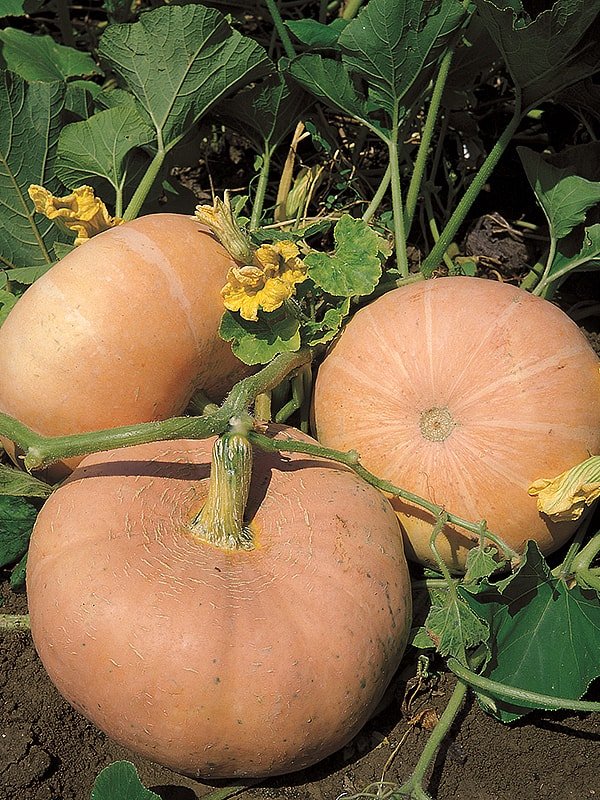

The peel of large-fruited pumpkins is often thin and quite amenable to cutting.
Hard-bore gourds are difficult to clean. Their peel is so dense that it has to be softened beforehand in order to be able to work with a knife. Hard skin protects the fetus from damage and decay. Hardy varieties are stored for a long time, they perfectly tolerate transportation over long distances. Some of the brightest representatives of this group: Kroshka, Sweetie, Champagne Pastila.
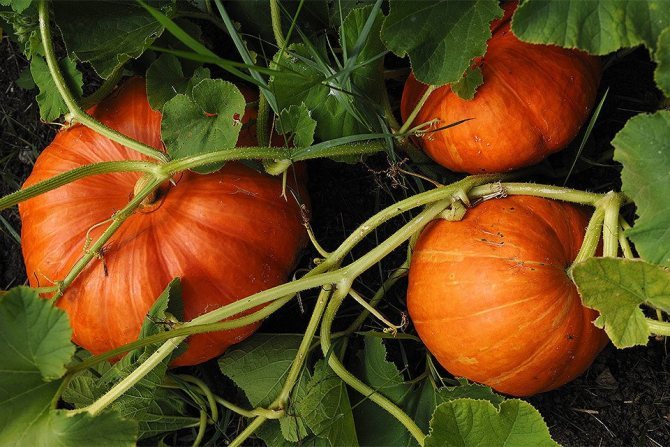

Hard-skinned pumpkins require the use of tricks when cleaning, just like that, even a knife will not give them
Pumpkin harvesting rules: terms, storage features
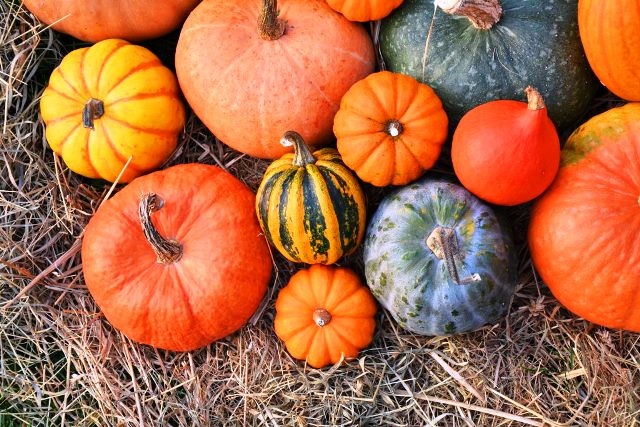

There are a large number of pumpkin varieties in the world. Breeders distinguish 3 main types: hard-bore, large-fruited, nutmeg. Harvesting a pumpkin requires an understanding of which type the variety belongs to, because they may have different ripening periods.
For every summer resident, the autumn time is the time for summing up and evaluating the results of the invested labor. It is very important at the final stage of garden work to avoid mistakes and to collect the fruits in time, carefully nurtured throughout the whole season.
In the harvester symphony, pumpkin is one of the final chords. Its cold resistance and unpretentiousness allow you to leave the vegetable in the garden until frost, especially since the fruits ripened on the whip are the most useful and tasty. As a rule, the timing of pumpkin harvesting depends on two main factors: the ripening period of the variety and the climatic conditions of the growing region. Moreover, the second point is often of decisive importance, especially for the middle zone and more northern regions.
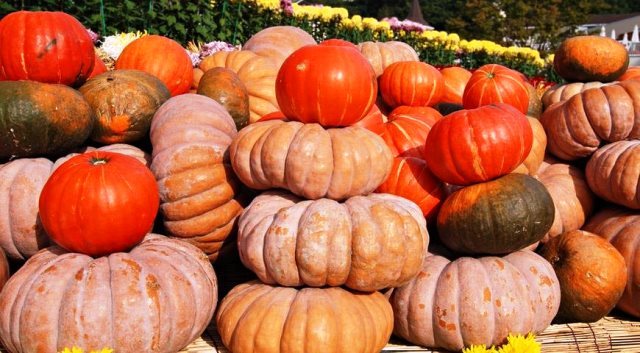

Signs of a ripe pumpkin
Criteria for determining the ripeness of a pumpkin:
- the stalk dries up completely and begins to resemble tree bark;
- the peel has hardened and become hard: to check it is necessary to press on it with your hands - if at the same time it is not damaged, then the fruit is ripe;
- changing the color of the pumpkin from green to orange or cream;
- yellowed or drying leaves of the plant.
Do not overexpose the fruits in the garden.
It is important to collect ripe pumpkins at the right time, otherwise there is a threat of damage to vegetables by mold or fungal diseases, which will damage the pulp and rind, seeds. Overexposing the fruits in the garden is not worth it, because pests can spoil them.
Excessive sun exposure of the vegetable will also not benefit the taste of the pulp.
Ripening dates of pumpkin
In addition to visual signs, the declared duration of the growing season of a particular variety will help to navigate the timing of harvesting.
- For regions with short summers, landing is most relevant early ripe pumpkins... Most often these are hard-bore varieties that ripen after 3 months of growing season. Their pulp is not particularly tasty and is not at all rich in substances valuable for our body. Therefore, most often these pumpkins are grown for the sake of remarkably tasty and very healthy seeds.
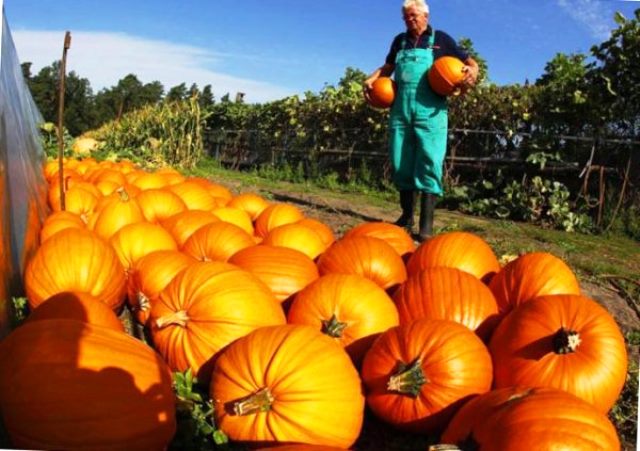

- Harvesting dates for hard-bore fruits usually fall on the last decade of August. Leaving them in the garden until September is not recommended, since the pulp of overripe specimens becomes loose.
- The most popular among gardeners are pumpkin, medium ripening... Usually these are large-fruited varieties that differ from their hard-bore counterparts in more tasty pulp and excellent keeping quality. They reach full ripeness after 4–4.5 months. Such fruits contain high concentrations of carotene, sugars, macro- and microelements, vitamin C and vitamins of group B. Large-fruited pumpkin can be stored for a long time only if it was removed from the garden before the first frost. Therefore, in the Siberian regions or in the middle lane, harvesting is usually carried out until the end of September, and then the pumpkins are ripened for two to four weeks in a warm place with low humidity.
- Among the late varieties, nutmeg varieties are most often found. They are the tastiest, but the most whimsical and thermophilic. Fully ripen in the garden late pumpkins can only in the southern regions with a long summer, because their ripening period exceeds 4.5 months. In more northern regions, nutmeg varieties are harvested before the arrival of frost and ripened for one to two months, and then eaten as soon as possible, since they are not stored very well (4–5 months).
Features of harvesting fruits
When the crop is harvested, everything is harvested at once, without leaving it to ripen. They can be eaten immediately or made for winter preparations, but many gardeners leave vegetables to be stored for the winter, because pumpkin is a great help in winter. Rich in vitamins, it will be an indispensable element in many dishes.
For long-term storage of the pumpkin when harvesting it from the garden, it is important to leave the stalk 4-10 cm long. If you remove the stalk, the vegetable begins to be affected by bacteria and deteriorate. After harvesting the pumpkin, it must be dried under a canopy in the fresh air for better storage.
Harvest storage
There is an opinion that pumpkin has the property of being stored for up to 2 years, but this largely depends on the conditions of temperature and humidity.In this case, the chemical composition of the fetus can change dramatically.
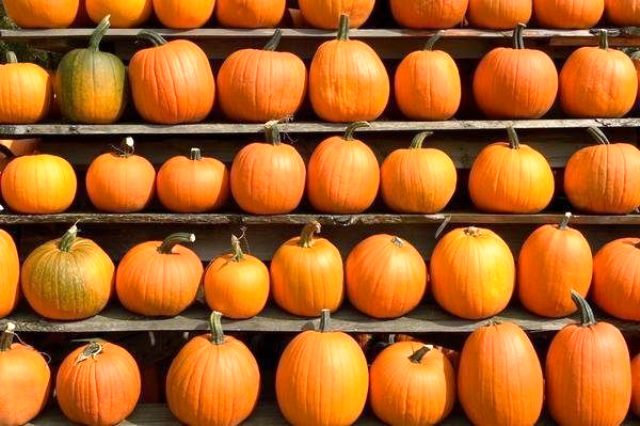

Important rules must be observed that will significantly increase the safety of the crop:
- all the fruits must not be thrown into a heap: they must be arranged in rows with the stalks upward, and the aisles must be covered with hay or straw;
- be sure to put something under the vegetables: it can be blankets, boards, straw, hay;
- it is important to get rid of rodents before storing, because they will surely enjoy the harvest, destroying it;
- it is necessary to check the fruits for damage - vegetables with them must be consumed first, because such pumpkins will not be stored for a long time and can infect neighboring ones.
During the storage period, the vegetable loses weight due to moisture loss, therefore, they often resort to creating stocks using canning, freezing, and drying.
By adhering to the basic tips for determining ripeness, harvesting and storing pumpkins, you will be able to preserve the fruits until the next season, and perhaps even until the next ripening period. Having collected ripe healthy fruits, you also get strong seeds suitable for future planting.
Why the pumpkin is a symbol of Halloween
Probably each of us has ever wondered what a pumpkin for Halloween means. The origin of the modern Halloween symbol is explained by an old Irish legend.
It tells the story of the cunning drunkard blacksmith Jack, who twice trapped Satan himself. Wanting to free himself, the deceived devil was forced to promise Jack not to interfere in his life and not take his soul after death.
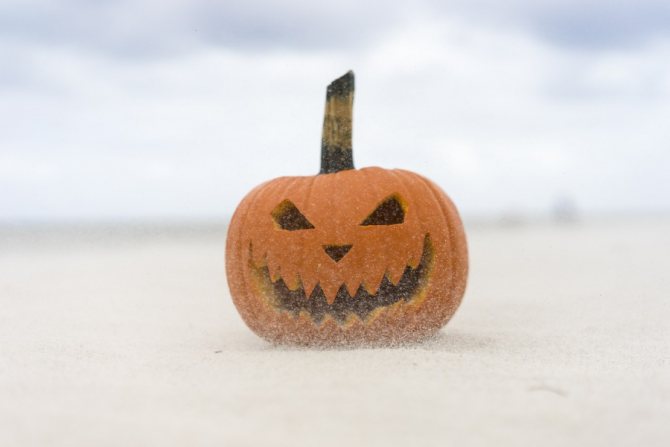

When Jack died, he could not go to heaven or hell. Both God and Satan, true to his word, closed their domains to him. At parting, the devil threw a small coal to Jack so that his restless soul could light his way. Jack put the ember in the pumpkin, protecting it from the rain, and went to wander the earth in anticipation of the Day of Judgment.
Interesting! Halloween pumpkin is called Jack's lantern (or lantern).


This is how a vegetable with a spark inside became a symbol of a soul that cannot find peace after death. Thus, such a mysterious story has developed.
In addition, many people traditionally associate a vegetable with the autumn harvest, and someone believes that a light and an evil face scare away evil spirits, which, according to beliefs, cross the border between the world of the living and the dead on the night of October 31 to November 1.
Agree that this story makes you want to carve a pumpkin for Halloween even more!


Preparing for cleaning
The dense skin of the pumpkin is difficult to cut, so it is important to choose a sharp knife with a comfortable handle and a blade 10-15 cm long. Hard-corked grades lend themselves better to a serrated cutter. For varieties with thin skin, you will need a metal spoon and a peeler.
Small fruits
Small fruits, the diameter of which does not exceed 10-15 cm, are washed under the tap in the kitchen sink or in a basin of water. Having cleared of dirt and dust, they are dried using thick paper napkins or a clean cotton towel. For specimens that fit in the palm of your hand, this is enough to move on to the next stage.
If the pumpkin cannot be gripped with one hand or is uncomfortable, first cut it in half. Divide the vegetable that has a pronounced relief according to the available segments, so it will be easier to peel.
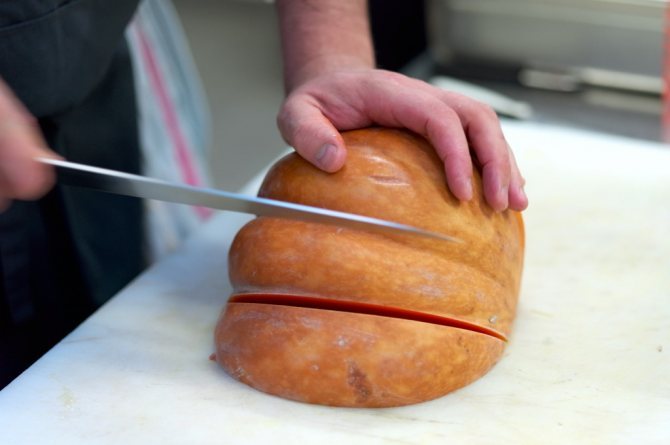

Segmented pumpkin is most conveniently cut in half moons, and then peeled each piece separately.
Large fruits
Pumpkins with a girth of 20-50 cm or more are more convenient to wash in the bathroom with a shower. After that, they are also dried with a towel.
If there is not enough space in the kitchen, then carry out the first stage right in the bathroom, dividing the fruit into two halves. To do this, stick a wide knife into one of the poles of the vegetable and turn it so that its pulp begins to crack, but do not break the pumpkin.Once you get a small hole, cut the fruit along its entire circumference, gradually turning it over. If after that the pieces are too large, divide them into quarters and work with them in turn.
Large-sized pumpkins are more difficult to handle due to their weight and scale, so for convenience, immediately prepare a place sufficient for comfortable movement and placement of parts of the fruit. Place freezer bags and cling film in an accessible place to free up space faster. Then unclaimed pieces can be immediately removed for storage.
Removing seeds
The method of removing seeds from a pumpkin depends on the chosen dish or preparation.
Method number 1
Cut off the stem and top of the pumpkin. Do not regret to separate a layer of 3-10 cm, otherwise it will not be possible to reach the seeds. Use a spoon to remove the core. You will get a kind of pot in which the selected dish is baked.
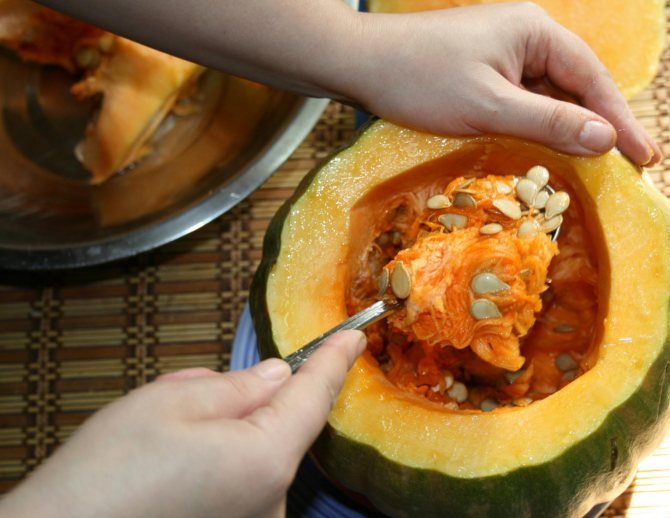

If you peel the pumpkin in this way, it can be used as a dish for cooking vegetable casseroles, hearty cereals and serving soups.
Method number 2
Divide the vegetable in half lengthwise. If the fruit is very large, first cut off the tops of the poles to place it firmly on the table. Remove the seeds from each half. When handling juicy pumpkin varieties, do not press down hard on the spoon. Because of this, the pulp will juice, and further cleaning will be inconvenient.
Small fruits and nutmeg species are also cut across. These pumpkins have a small seed diameter, so cleaning takes 1–2 minutes.
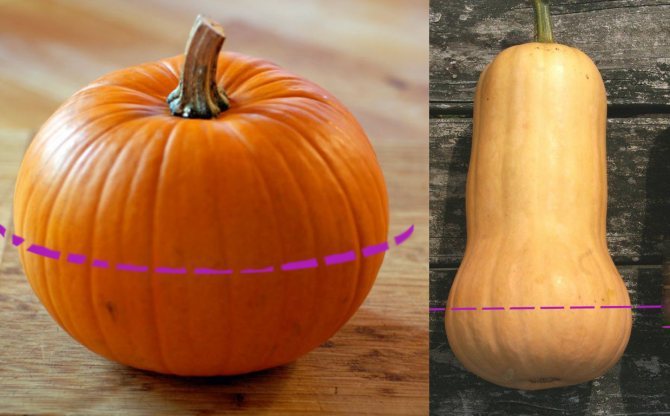

Small fruits are easier to peel when cut across
Method number 3
In a segmented pumpkin, divided into half-moon parts, the fibers with seeds are removed with a knife. Depending on the size of the pieces, choose a short or long blade to cut off excess in one stroke. In the same way, the pulp is removed from the bark.
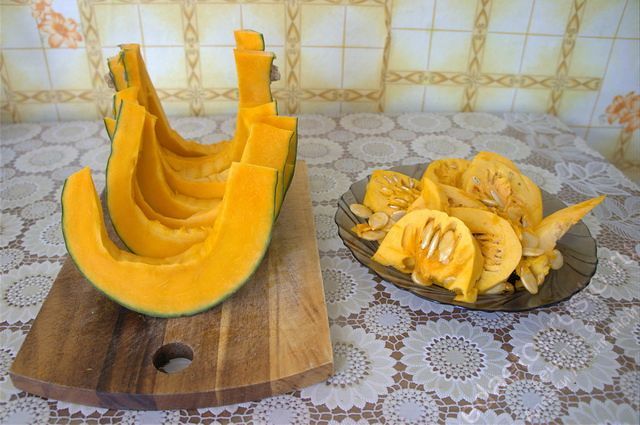

If you cut the pumpkin into half-moon pieces, remove the seeds and cut the skin off.
How to quickly peel raw pumpkins
The difficulty of cleaning depends on the density of the skin and the shape of the fruit. Instances that belong to the large-fruited species, but have a small diameter and weight, are peeled with a knife, like an apple or a potato. With hard-core varieties, this will not work, and nutmeg pumpkins are not always convenient to hold in one hand, so they take into account some of the nuances of peeling in such cases.
With a round
The algorithm for peeling a round pumpkin is as follows:
- Large-fruited, characterized by a large diameter, and almost all round-shaped hard-bore pumpkins are first divided in half.
- The parts are stacked with cuts down so that they do not slip on the working surface.
- Holding the piece with one hand, slightly pressing on it for greater fixation, gradually cut off individual sections of the peel with a sharp knife. Slice thickness 1–2 cm.
In the case of a flattened segmented pumpkin, it is easier to peel each crescent separately.
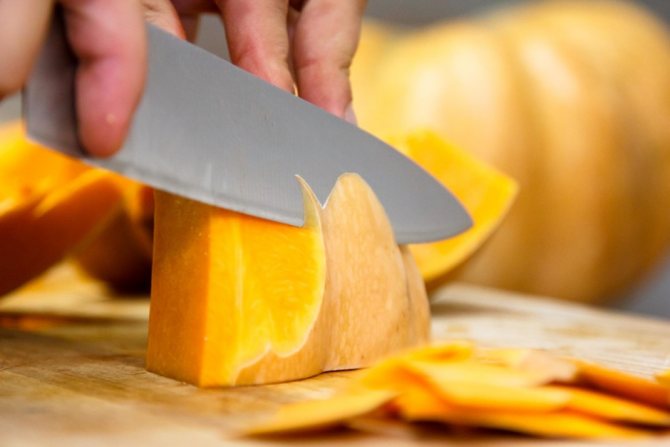

For the convenience of cutting the peel, the fruit can be divided into several parts.
I have peeled a large pumpkin. It was a large-fruited species of the Russian size variety. She weighed a little over 23 kg and was very large in diameter, she had to be moved by the whole family. There were no suitable tables for setting up such a crop, so the first stage of cleaning and cutting had to be done on the kitchen floor. First, I removed the stalk and, using a wide, hard-bladed knife, I marked the cut lines along the pumpkin. Moving the blade, she rocked it from side to side to cut the fruit in half. Then I divided each half into two more parts. The quarter turned out to be the easiest to work with. At this stage, I removed the bark from the pulp. To further simplify the process, this piece could be divided into several strips of small width. Then it would not be difficult to peel them off with a simple knife.


There are two options for removing the skin from individual segments of the embossed pumpkin
With nutmeg
For peeling pear-shaped gourds, it is recommended to use a cross-cut and remove the peel alternately from the top and bottom. The skin of nutmeg varieties is thin, so the cut should be 0.5–1 cm. If you need circles or cubes of pulp for cooking, then immediately cut the fruit into rings and peel off the shell in a circle from each of them with a small knife.
The quickest way is to cut the bark of the butternut squash with a triangular potato peeler.
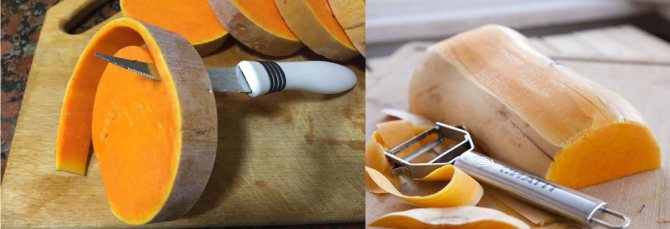

There are two peeling methods to help you quickly peel butternut squash.
How to remove seeds and pulp easily
Pumpkin seeds are very healthy. They are used for several purposes at once:
- in folk medicine;
- as a tasty product rich in vitamins and minerals;
- for breeding pumpkin;
- for decorating dishes.
It is recommended to remove pumpkin seeds immediately after cutting the vegetable. They can be collected by hand, rinsed and dried by spreading on a flat surface in a thin layer.
After cutting the pumpkin, it is imperative to remove the pulp and seeds from it. It is convenient to remove the pulp with your hands or a tablespoon. If you want to keep the shape of the pumpkin, you can cut off the lid and carefully remove the pulp with seeds using a spoon on a long handle.
The pulp is not eaten. It deteriorates very quickly. If left on, the cut fruit will start to rot within a few days.
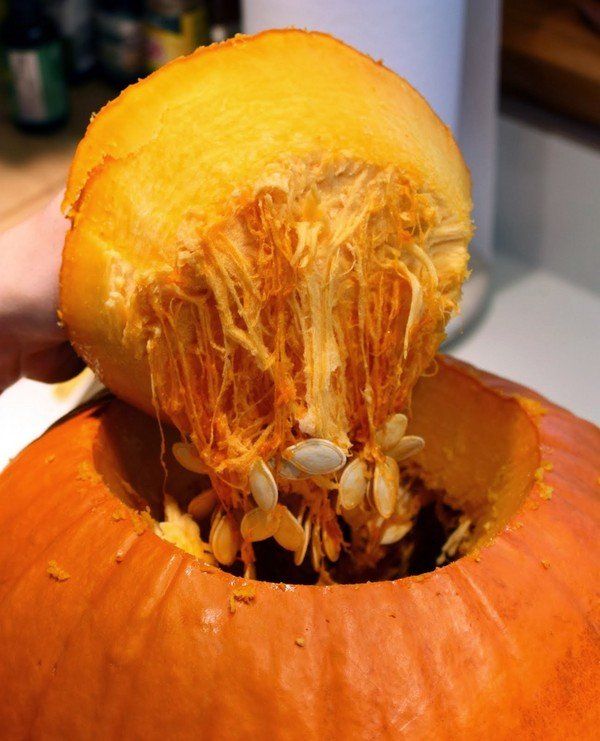

Seeds and pulp can be removed by cutting off only the top cap on the pumpkin
Pumpkin seeds should be collected, washed and dried, spreading on a flat surface in a thin layer. If the pumpkin is varietal, the seeds can be saved and used as planting material. The seeds of hybrids are not suitable for these purposes. After removing the pulp and seeds, you can rinse the pumpkin slices with water and dry them if you need to extend the shelf life of the fruit.
A special feature of butternut squash is the small seed chamber located at the bottom of the fruit. To peel such a pumpkin, it is better to pre-cut it across.
Seed release
Any housewife should remember that no pumpkin dish is cooked with seeds. They must always be removed along with the fibers. There are specific rules that can teach everyone how to clean the inside of a pumpkin. The process is quite simple and does not involve the use of any complex instruments or equipment. Everything is extremely simple. True, there are two cleaning options:
1) Whole fruit. This is done when the pulp, together with the peel, participate in the cooking process and act as an improvised dish. In addition, a whole pumpkin is cleaned once a year for Halloween.
2) Separate parts. This option is convenient for preparing dishes in which the pulp will subsequently need to be chopped.
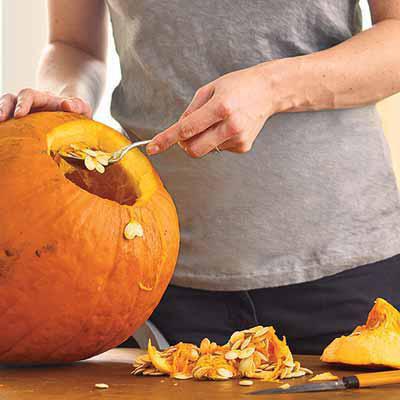

Cleaning a pumpkin is not difficult at all, for this you need:
- Wash the vegetable well so that no dirt remains on it.
- With a sharp knife, cut off the upper part near the tail. It is better to keep the blade at an angle in order to partially remove a small layer of pulp together with the "cap".
- Then, using a simple tablespoon, gently scrape out the fibers with the seeds, periodically pulling them out.
The resulting workpiece can be further used for its intended purpose.
Cooking pumpkin dishes most often requires removing the skin beforehand. Hard-skinned vegetables are not easy to peel, so there are some tricks you need to know to peel them.
Drying pumpkin seeds in the oven
You can dry pumpkin seeds in an oven as follows:
- First you need to bring the temperature in the oven to 60-80 degrees.
- Then grease a wide baking sheet with vegetable oil and put the seeds dried after washing on it.
- The baking sheet must be installed exactly in the middle of the oven.
- Drying the seeds in the oven will take about 20-30 minutes. During this time, they need to be stirred periodically.
After cooking, the seeds are best tested for taste: they should not be wet or crunchy on the teeth.
After this procedure, pumpkin seeds can be stored for quite a long time. It is recommended to put them in a cloth bag and keep them in a dry and dark place.
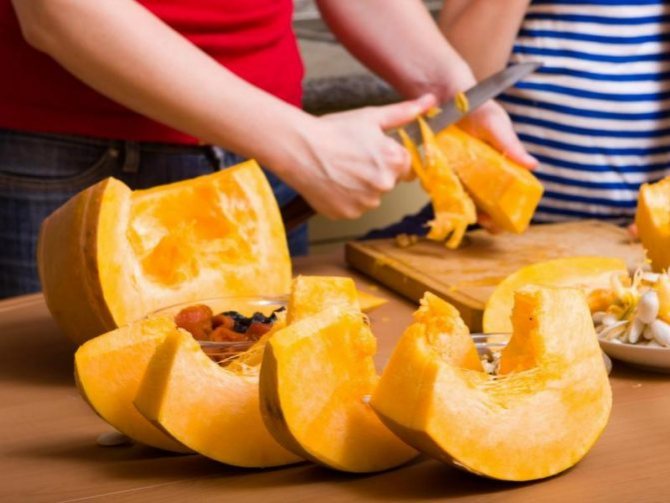

Peeling the pumpkin takes 3-10 minutes. Processing time depends on the type of fruit, the softness of the skin, the size and shape of the vegetable. If you are doing this for the first time, the process may seem time consuming, as it requires a certain dexterity and physical strength. Simple tips for beginners will help you cope with this task.
Long-term drying technique and its nuances
Pumpkins are only dried naturally. In an electric dryer or oven, this result cannot be achieved, even if you spend several days on it and use the minimum temperature. At first, it may indeed seem that the product has reached the desired degree of density, but this opinion is deceptive.
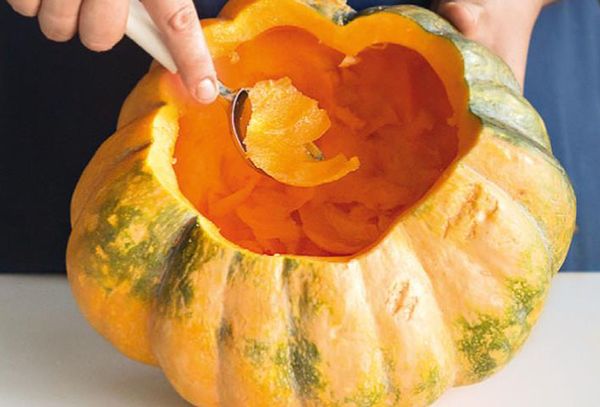

Drying pumpkin for decoration should be carried out according to the following scheme:
- First, preparation is carried out, during which the surface of the fruit is thoroughly washed using a soap solution. After that, we dry the pumpkin and wipe it with an alcohol-containing liquid.
- Then the workpiece must be temporarily sent to a room with good ventilation. The product must not be exposed to direct sunlight.
- After 1-2 weeks of this exposure, the surface of the vegetable will change its color and become much harder. This is a signal that you can move on to the next stage.
- Now the most simple but tedious time begins. Final drying of the product takes up to six months, after which the component becomes as hard as wood. All this time, the workpiece must be in a room with good ventilation and a minimum of light. Better if it is suspended from the ceiling. If it is not possible to organize such drying, we make stands with holes through which the product will be constantly blown.
- During the initial drying phase, pumpkin should be checked regularly. Fruits that rot or wrinkle should be thrown away, they will no longer work for anything. If mold appears on the hard bark, we try to gently wipe it off with a dry cloth. If the material under the colony softens, the product is discarded.
- The vegetables should be rotated every couple of weeks so that they do not develop "bedsores" and dry evenly.
As soon as the pumpkin becomes light, and the seeds begin to rustle inside it, we can assume that drying is complete. The product can now be processed as intended. They grind it, rub it with sandpaper, cut out drawings on the surface. Varnish and various paints perfectly fit on natural material. It holds the glue on which the decorative elements are placed. If everything is done correctly, such a product will serve for years.
Why leave the skin
Although there are much fewer recipes using all parts of the pumpkin, nutritionists advise not to remove the top layer, since it contains natural wax that helps fight parasites and mycoses inside the human body.
Tomato eupator: description and characteristics of the variety
The whole pumpkin recipe is pretty simple. The vegetable, washed and peeled from seeds, is cut into pieces and baked in the oven until the skin is softened. Serve with chicken, fruit sauce, or eaten separately. During cooking, the peel protects the fibers from complete decay and retains beneficial substances inside the pulp. Of course, this is food for everyone and not everyone will be delighted with the pumpkin top layer crunching on their teeth, but it is also a good scrubbing cleaning for the body.
You can also leave the skin in the preparation of a smoothie, and in order to make the vegetable easier to grate, first freeze the pieces for 3-4 hours, then take them out and use a blender to grind them into gruel. You can add a little flaxseed or kiwi to enhance the cleaning effect.
It will turn out to bake delicious cookies from the peel, after collecting and drying it, then grinding it into flour. In this version, there is a lot of sucrose, protein and silicon, which are useful for the female body. Some cooks make delicious jam, candied fruits from the peel, offer recipes for compotes and aromatic tea.
Mandatory procedure
Every person uses certain vegetable dishes in their diet almost every day. True, this does not happen with pumpkin as often as, for example, with potatoes. Although it should be noted that the benefits of this product are much greater. Its use helps to improve vision and normalize digestion, extinguish inflammation and strengthen immunity. Therefore, you should not leave your body without such a strong assistant. Moreover, pumpkin dishes are not only healthy, but also very tasty. It is used for making various soups, cereals and casseroles. Excellent stews and pancakes are made from this vegetable, cookies and pies are baked, and fragrant tea is also brewed. Any of the recipes listed are noteworthy, but they all start with the same procedure. You need to know how to peel a pumpkin.
Of course, first, like any product, you need to thoroughly wash it. After all, such a beauty grows in the garden and has direct contact with the ground. Therefore, first of all, the surface must be doused under a stream of running water. Further actions depend on the characteristics of a particular recipe. But in most cases, housewives have to decide how to clean the pumpkin.
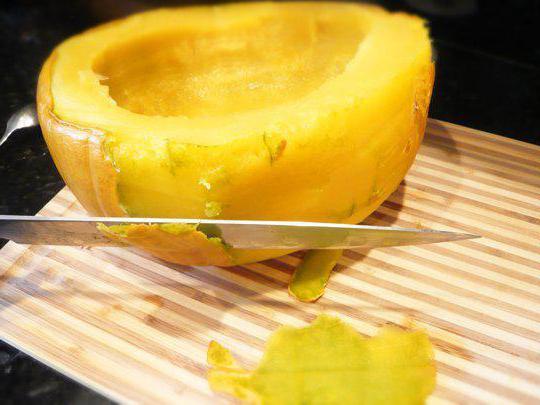

The easiest way is to cut it lengthwise, and then methodically cut off the thick skin with a sharp knife. But this is not always the case.
Peeling pumpkin
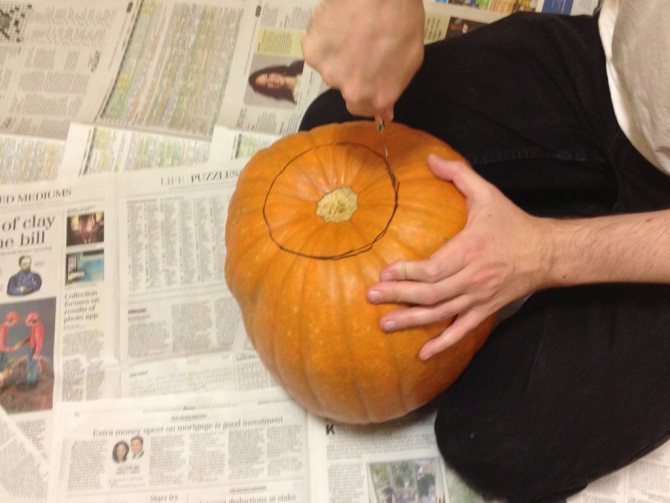

- Take your pumpkin and rinse thoroughly.
- Cut off the top and bottom of it, as you do with cucumbers, for example. Cut the pumpkin into two halves by cutting with a large knife.
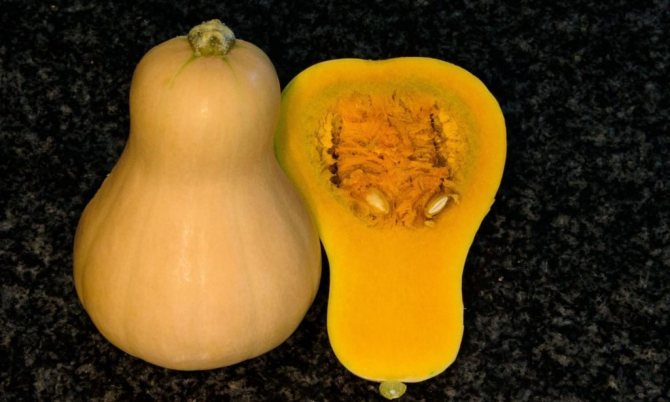

- This way you get two halves with seeds inside. Remove them with a tablespoon. It should be clean inside.
- The core must be cleaned, otherwise you will not be able to cook this vegetable.
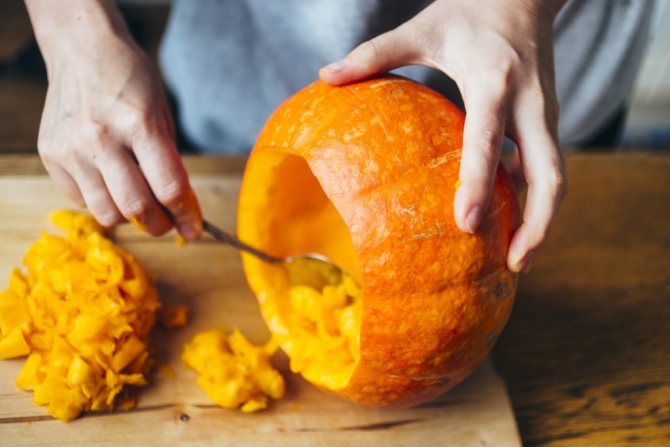

Each half should now be peeled from the top rind. Now you can chop, most conveniently in slices.
Contraindications
Before telling how to peel a pumpkin, you need to figure out who should not use this product. This vegetable is not recommended to be included in the diet of people in whose body the acid-base balance is disturbed.
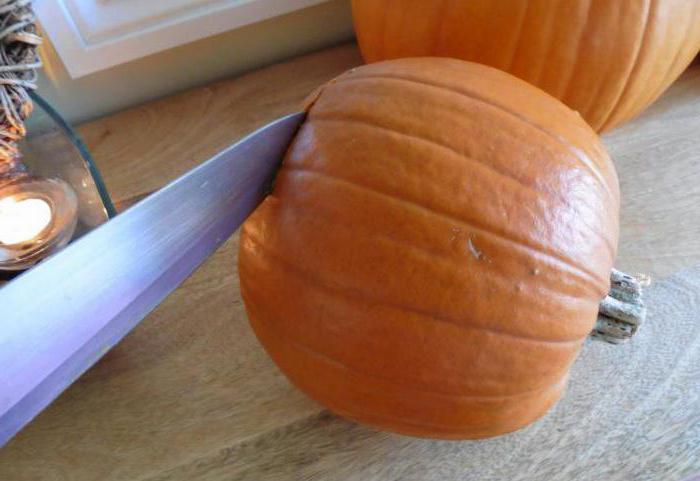

It is also advisable to exclude pumpkin from the menu of those who suffer from gastritis, peptic ulcer disease or diabetes mellitus. It is also contraindicated for those who often have bloating. For everyone else, it will do nothing but benefit.
Mandatory procedure
Every person uses certain vegetable dishes in their diet almost every day. True, this does not happen with pumpkin as often as, for example, with potatoes. Although it should be noted that the benefits of this product are much greater. Its use helps to improve vision and normalize digestion, extinguish inflammation and strengthen immunity. Therefore, you should not leave your body without such a strong assistant. Moreover, pumpkin dishes are not only healthy, but also very tasty. It is used for making various soups, cereals and casseroles. Excellent stews and pancakes are made from this vegetable, cookies and pies are baked, and fragrant tea is also brewed. Any of the recipes listed are noteworthy, but they all start with the same procedure. You need to know how to peel a pumpkin.
Of course, first, like any product, you need to thoroughly wash it. After all, such a beauty grows in the garden and has direct contact with the ground. Therefore, first of all, the surface must be doused under a stream of running water. Further actions depend on the characteristics of a particular recipe. But in most cases, housewives have to decide how to clean the pumpkin.
The easiest way is to cut it lengthwise, and then methodically cut off the thick skin with a sharp knife. But this is not always the case.
How to remove seeds
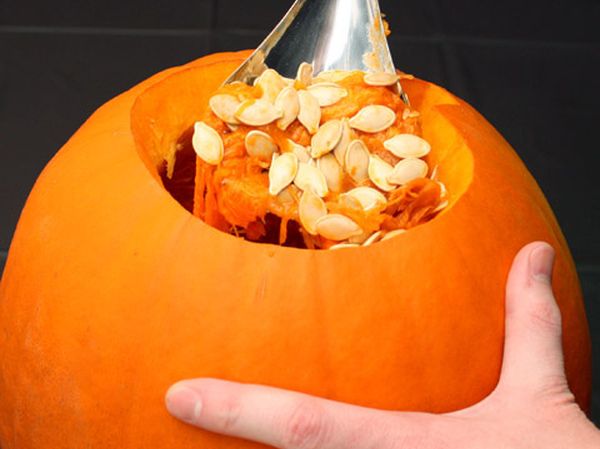

Another important point is the removal of seeds from the middle of the vegetable, since it is unlikely that you will be able to cook a tasty dish with them. To get the inside peeled pumpkin parts, you need to cut the selected instance in half. Then, using a spoon, remove the seeds from the vegetable parts along with the orange pulp fragments and place on a plate. Then you can continue cooking the fruit dish. If you plan to use seeds, then they are laid out in a sieve, washed, put on a board and rolled over them with a rolling pin. Then they are poured into a saucepan with boiling water, boiled for 5 minutes, thrown into a colander, dried and peeled.
Surface treatment
Most often, nutmeg pumpkin, familiar to everyone, is used for cooking. Its bright orange pulp, when boiled or stewed, gives the finished product a pleasant, delicate aroma. To isolate this part from the product, you need to know how to peel the pumpkin. This will require a certain skill and the availability of the necessary tools. To get started, there should be on the table: a cutting board and two knives (a sharp large one and a vegetable one with jagged edges).
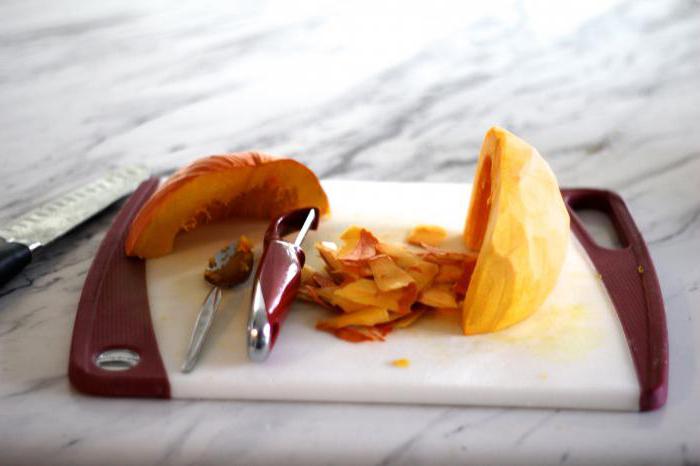

After that, it is necessary to perform the following steps one by one:
- Dry the washed vegetable with a napkin or towel.
- Place it on a board and use a large knife to cut off both ends at a distance of approximately 2.5 centimeters. These parts will not be used in cooking, so you can safely throw them away.
- With a vegetable knife, going slightly deeper, draw on the surface of the pumpkin, gradually removing small pieces of the peel. In this case, the vegetable can be placed both vertically and horizontally. It all depends on how it is more convenient for the hostess to hold it.
How to store peeled pumpkin
So, the pumpkin is ready for cutting and processing for later storage. Sliced pumpkin is stored in the refrigerator for a maximum of a week, and the thermally processed product is even less.
- It is better to freeze it by cutting it into cubes, or, if there is no freezer, dry it in an oven or electric dryer.
- Dried pumpkin is easy to store in ordinary glass jars in a dry place, it retains its beneficial properties throughout the winter.
Now it is clear how to peel a pumpkin from a tough peel before cooking various dishes, freezing or drying for the winter. Knowing about the above tricks, not a single housewife will refuse to pamper households with dishes made from tasty and healthy pumpkin fruits, and will keep the harvest without loss.

